|
|
|
Galfetti, Mariuccia and Nuria Homs (Antoni, Antonio Tapies)
Antonio Tapies. Obra grafica. Graphic Work. 1979-1986. (Catalogue raisonne of the prints of Antoni Tapies)
The third volume of the catalogue raisonne of Tapies' prints, covering the years from 1979 to 1986 (nos. 708 to 1088). Text in Spanish and English. All items illustrated, several color plates. 4to, publisher's cloth. Fine in a fine dj. Like new.
|
|
|
GALLE Cornelius
Crescetis amores. (Vénus allaitant les amours)
Tirage tardif (?) pour cette agréable estampe d'après Rubens. B.44 en feuille Très bon 22 x 17 cm
Bookseller reference : 8653

|
|
|
GALLE Philip
Scène de pêche : des chiens participent à la pêche, les hommes sont armés de tridents. D’après Jean Stardanus. Contrecollée. XVIè (1578) 20,5 x 29,5
Bookseller reference : 6601
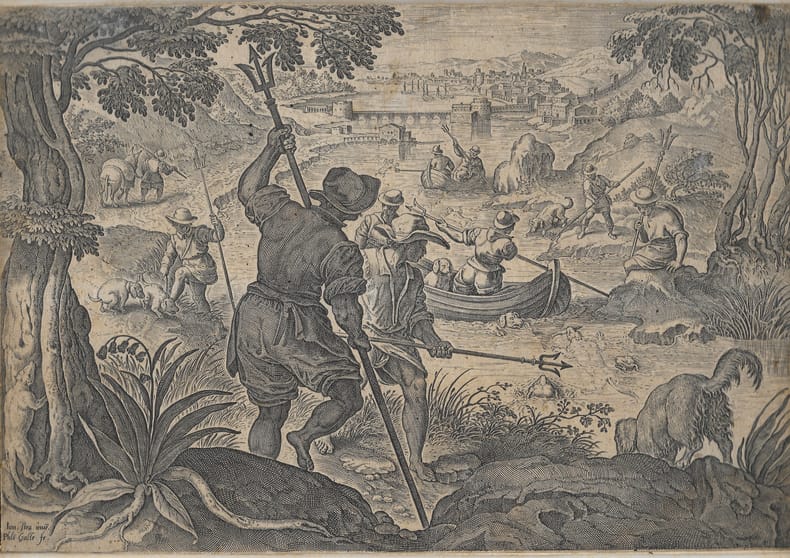
|
|
|
GALLE Philips
Sacerdotum concilio sistuntur
Quatrième gravure d'une série consacrée à l'histoire de Pierre et Jean. D'après Marten van Heemskerck. Excudit de Cock de 1558. En feuille. Ancienne réparation dans l'angle supérieur droit. Moyen haarlem Cock 1558 20,5 x 25 cm
Bookseller reference : 14690
|
|
|
Galliner, Arthur
Max Liebermann: Der Künstler und der Führer [SERIES]: Jüdische Jugendbücherei.
Contains b&w plates. 205x155mm. 63 pages. Hardcover. Gilt lettering. Front cover slightly bent. Cover corners slightly bumped. Spine edges slightly worn. Stamp and sticker on front inner cover. Binding visible between pages 32-33. Pen inscription on first whitepage. Stamp on second whitepage. Pages slightly yellowing. Else in good condition.
|
|
|
GALTON FRANCIS. FINGER PRINTS AND CRIMINOLOGY
The Patterns in Thumb and Finger Marks; on their Arrangement into naturally distinct Classees the Permanence of the Papillary Ridges that make them and the Resemblance of their Classes to ordinary Genera." And same author: "Methods of indexing Finger Marks.
Lindon Harrison and Sons 1890-91. Bound together in recent marbled boards. With both titlepages to vols 48 and 49 both 1891 in "Proceedings of the Royal Society of London" pp. 455-459 in vol. 48 and pp. 540-548. � "The Patterns in Thumb and Finger Marks" is an early 'abstract' read to the Royal Society. The full paper paper appeared later the same year. "Methods of indexing Finger Mark" being the first appearance. These two paper constitute the very first appearance of the anthropometric classification of fingerprint.<br>"Galtons establisment of fingerprinting as an easy and almost infallible means of human identification transformed a difficult subject and his taxonomy of prints is basically that used today".DSB. hardcover
Bookseller reference : 39153
|
|
|
GALUZZI (Marc) ?
Dernière découverte zoologique. Espèce très dangereuse!!!
33X50 cm.
Bookseller reference : 16335
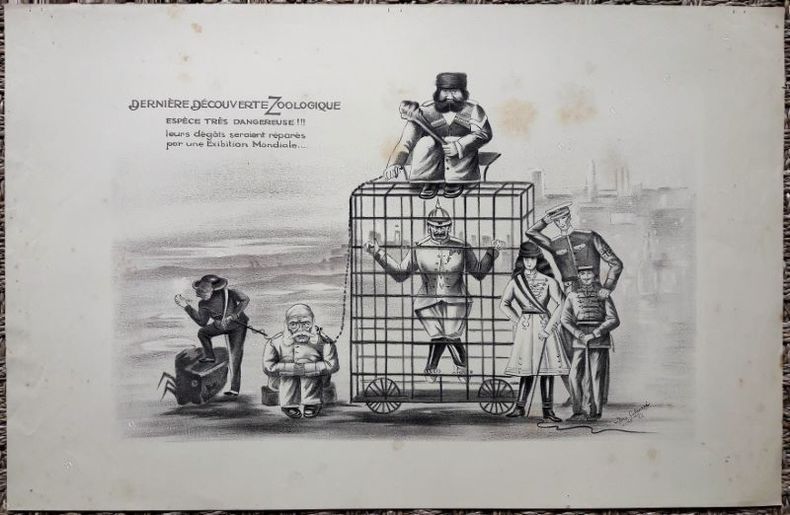
|
|
|
Gambke, Ulrich; Weidmann-Zweifel, Afra
Tal der Linth.
Glarus, Tschudi, 1993. 4°. 208 Seiten. Mit 61 farbigen und 29 s/w ganzseitigen Abbildungen. Orig. Leinen mit Schutzumschlag. + Wichtig: Für unsere Kunden in der EU erfolgt der Versand alle 14 Tage verzollt ab Deutschland / Postbank-Konto in Deutschland vorhanden +
Bookseller reference : 21669AB
|
|
|
Gambke, Ulrich; Weidmann-Zweifel, Afra:
Tal der Linth.
Glarus, Tschudi, 1993. 4°. 208 Seiten. Mit 61 farbigen und 29 s/w ganzseitigen Abbildungen. Orig. Leinen mit Schutzumschlag.
Bookseller reference : 21669AB
|
|
|
GANDINI, Gino (Reggio Emilia 1912-2001),
La strada di Enrico IV
Acquaforte originale Firma a matita. Certificato di autenticità rilasciato dall'Inclub. Esemplare 7/40. cm 29 x 19,7 (Foglio 70 x 50). pp.. . Ottimo (Fine). . 40. .

|
|
|
GANDINI, Gino (Reggio Emilia 1912-2001),
Puianello
Acquaforte originale Firma a matita. Esemplare 7/40. Cm 29x18,5 (Foglio 70x50). pp.. . . . Tiratura 40. .

|
|
|
GANGLOFF Pierre
Dehors.
Jean-Pierre Huguet Carnets des Sept Collines Jean-Pierre Huguet, Carnets des Sept Collines (N°25), 2007, 43 p., broché, environ 23x12cm, exemplaire numéroté 39/100, avec un envoi et un frontispice signé de l'auteur, bon état.
Bookseller reference : 102091
|
|
|
GARCIA-CALDERON José
La Cape écossaise. Cape pour le théâtre (pl.32, La Gazette du Bon ton, 1914 n°4)
Lucien Vogel éditeur, Paris Avril 1914, 19x24,5cm, une feuille.
Bookseller reference : 84718
|
|
|
GARELLI, Franco,
Caso di uomo
8 litografie originali in nero, numerate e firmate di Garelli (cm 35x25). Un testo dell'A. riprodotto litograficamente al risvolto della copertina Copertina originale dell'A. Stampa curata dall'A. eseguita con torchio a mano dal maestro Corsino. Pietre distrutte dopo la tiratura. Cm 25x35. pp. 8. . Molto buono (Very Good). Fioriture leggere alla copertina (Some light yellowing at the covers). Edizione originale di 75 es. numerati. .

|
|
|
Garfield Leon & Lawrence J Engravings
The Sound of Coaches
London: Puffin 1978 rep. 0140309616 . Pbk; Vg; . London: Puffin, 1978 rep unknown
Bookseller reference : 39001 ISBN : 0140309616 9780140309614

|
|
|
Garfield Leon & Lawrence J Engravings
The Sound of Coaches
London: Puffin 1977 - 1st thus. Very Good. 1977. 1st Puffin edition. 0140309616 . Pbk; Vg; faded spine; 1st Puffin edition ; Puffins . London: Puffin, 1977 - 1st thus unknown
Bookseller reference : 39000 ISBN : 0140309616 9780140309614

|
|
|
Garnier Jules
The Day of the Fete; by Jules Garnier 1 print from The Masterpieces of French Art
Paris: Gravure Goupil et Cie 1882. Near Fine -. The sheet is 11.5 x 15 inches; the image is 7.25 x 10 inches. The print is a black-and-white image of the painting The Day of the Fete by Jules Garnier 1839-1904. No date of publication. The series The Masterpieces of French Art was issued in the United States beginning in 1882. Portfolios containing several photogravure prints and several wood engravings were published on a monthly basis. Gravure Goupil et Cie became Boussod Valadon & Cie in 1884. This beautiful black-and-white print is very scarce. In Near Fine- Condition: corners rubbed; lower edge lightly soiled; image is clean and bright. <br/><br/> Gravure Goupil et Cie unknown
Bookseller reference : 004807
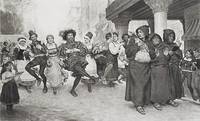
|
|
|
Garton European Prints VERY RARE
German Expressionist Prints
Garton London 1989 Very scarce and brilliant catalogue. Sixty Four prints brilliantly reproduced. Stiff card covers. Much sought after. Former owner blind stamp to introduction page. Enclosure with price list. Language: eng. Soft cover. Fine. Garton London paperback
Bookseller reference : ABE-1492682002481
|
|
|
GARTON EUROPEAN PRINTS
LOVIS CORINTH 1858 - 1925
Garton European Prints London 1990. First Edition. Illustrated Card Covers. Fine/No Dustjacket. Catalogue of an Exhibition of the work of Lovis Corinth as a Printmaker. There is a short Introduction followed by a Catalogue of 33 Prints drypoint and lithographs. All are illustrated and priced and annotated. Light shelfwear. Size: Quarto. Quantity Available: 1. Category: "Art Architecture & Design"; Pictures of this item not already displayed here available upon request. Inventory No: 027864. . Garton European Prints unknown
Bookseller reference : 027864
|
|
|
Garton European Prints; Corinth Lovis
Lovis Corinth 1858 - 1925
London: Garton European Prints 1990. 4to. wraps. 13 pp. Eng. Ill. 33 black & white plates. Exhib. 23 Jan - 28 Feb 1990. Pages dimpled; else VG. London: Garton European Prints, 1990 paperback
Bookseller reference : 59-2233
|
|
|
Garvey, Eleanor M. (Philip Hofer, intro.)
The Artist & the Book 1860-1960 in Western Europe and the United States
FIRST EDITION of this groundbreaking catalogue of livres d'artiste. 324 items fully described. Profusely illustrated in color and black & white. Large 4to. Publisher's cloth. Light general wear, but still very good in a very good dustjacket.
|
|
|
Gaselee Sir Stephen Introduction; Webb Margaret Wood Engravings Illustrator
Early English Recipes - Selected from The Harleian Ms.279 of About 1430 A.D.
Cambridge University Press. Very Good/No DJ. 1937. First Edition. Hard Cover. 8vo Brown cloth spine over decorative pasted paper boards anintricate black design on terracotta. Old recipes in early English with beautiful wood engravings by Margaret Webb. Clean and tight with no ownership inscription. A superior copy . Cambridge University Press hardcover
Bookseller reference : 136754

|
|
|
Gaskell Mrs.; illustrated with wood engravings by Joan Hassall
CRANFORD
London UK: George G. Harrap & Company Ltd. G/G. 1948. Reprint. Cloth w/DJ. 12mo. xxx 297 pp. DJ price-clipped. Dj rubbed yellowed chipped tape stains cover bumped page yellowing . George G. Harrap & Company, Ltd. hardcover
Bookseller reference : BOOKS251563
|
|
|
Gaston DE LATENAY (1859-1943)
LA MER SAUVAGE, gravure originale signée crayon, numérotée 2/50, titrée au crayon
Gravure originale signée au crayon et dans la planche, dans le coin en bas à droite, numérotée 2/50, titrée au crayon. Dimensions 55 x 38 cmEnvoi colissimo recommandé R2. Venez consulter l'ensemble de mes objets sur mon site antharedeschuyter.fr !
Bookseller reference : 4403
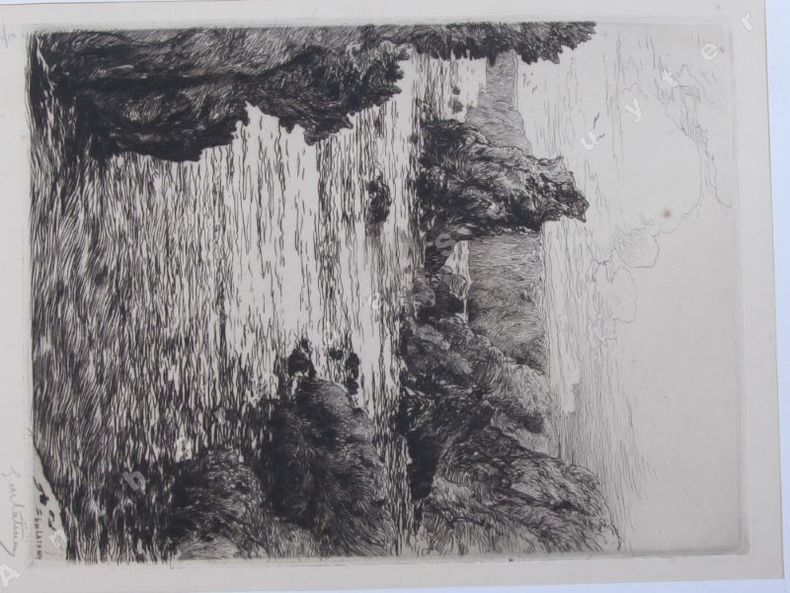
|
|
|
GATIER (Félix)
Pierre Gatier, 1878-1944. Catalogue raisonné de l'oeuvre gravé.
Dijon, L'échelle de Jacob, 2004. In-4 br. couv. rempliée ill. en coul., 317 ill. en coul. et n. et bl. in et hors-texte., biographie, index.
Bookseller reference : 567537
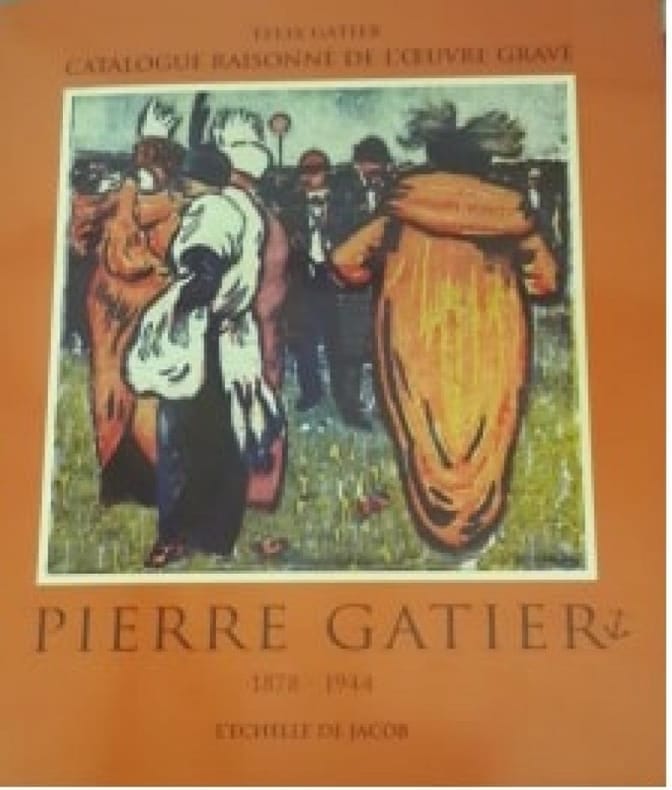
|
|
|
Gaudin, J(ean)
Flora Helvetica sive historia stripium hucusque cognitarum in Helvetia et in tractibus conterminis...
Zürich, Orell Fuessli, 1828?1833. 8°. Mit 28 kol. Kupfertafeln. Pappbände aus der Zeit mit verg. Rückenschild und Rückenvergoldung. + Wichtig: Für unsere Kunden in der EU erfolgt der Versand alle 14 Tage verzollt ab Deutschland / Postbank-Konto in Deutschland vorhanden +, 30176AB 7 Bände.
Bookseller reference : 30176AB

|
|
|
Gaudin, J(ean):
Flora Helvetica sive historia stripium hucusque cognitarum in Helvetia et in tractibus conterminis...
7 Bände. Zürich, Orell Fuessli, 1828–1833. 8°. Mit 28 kol. Kupfertafeln. Pappbände aus der Zeit mit verg. Rückenschild und Rückenvergoldung.
Bookseller reference : 30176AB
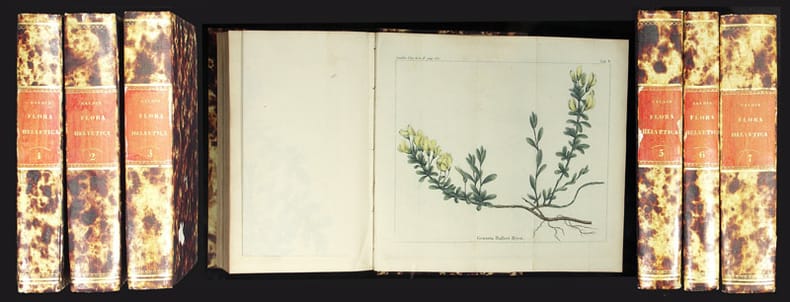
|
|
|
Gauermann, Friedrich, Maler und Graphiker (1807-1862).
Eigenh. Skizzenbuch. Niederösterreich u. a. O., 1830-1831.
45 Skizzen (einige laviert) auf 23 Bll. Originaler Halblederband mit Deckeltitel "F. Gauermann's Skizzenbuch v. J. 1830". Das Skizzenbuch enthält Baum- und Figurenstudien, Skizzen von Kühen in Ställen sowie Landschaftsskizzen. Einige davon sind datiert und beschriftet, u. a. "vom Ausflug mit Höger 1831. Oktober", "Mit Pollak und Höger 1831 im September", "mit Höger am 14. Oktober 1831 auf dem Rabenstein", "mit Höger im Thiergarten am 3. Dezember 1830". - Friedrich Gauermann unternahm mit seinen Schwägern, den Landschaftsmalern Joseph Höger (1801-77) und Wilhelm Pollak (1802-60), zahlreiche Reisen durch Österreich, wo Skizzen und Studien für spätere Ölgemälde angefertigt wurden. - Der Einband berieben und bestoßen, die Skizzen teils braun- und fingerfleckig und mit Klebeband im Mittelfalz fixiert.
|
|
|
GAUGUIN Paul & MONFREID George-Daniel de
Diane et Actéon aux Marquises. Noa Noa. Epreuve unique du bois dessiné et gravé d'après Paul Gauguin par George-Daniel de Monfreid
s.d. (1924), 93x78mm, autre.
Bookseller reference : 78248
|
|
|
GAUGUIN Paul & MONFREID George-Daniel de
Diane et Actéon aux Marquises. Noa Noa. Epreuve unique du bois dessiné et gravé d'après Paul Gauguin par George-Daniel de Monfreid
- s.d. (1924), 93x78mm, autre. - Diane et Actéon aux Marquises. Noa Noa. Unique proof of the woodcut drawn and engraved after Paul Gauguin by George-Daniel de Monfreid [between 1904 & 1924] | 9,3 x 7,8 mm | one sheet Original proof, likely unique, of this intermediate state of a woodcut drawn and engraved by George-Daniel de Monfreid after two works by Paul Gauguin. Print on Japan silk, annotation by the artist in the left-hand margin. Woodcut drawn and engraved after two works, the man holding a branch being a reproduction of a watercolor on page 37 of the Noa Noa manuscript, while the full-length woman originally observed by this browser, is presented here in bust with her hand to her face, model reproduced on a woodcut engraved by Gauguin on page 4 of the manuscript (and his original sketch pasted on page 51), evoking a similar scene. The final woodcut will serve as the head of chapter IV of the first true illustrated edition of Noa Noa, published by Crès in 1924, the first illustrated work after Paul Gauguin and a majestic tribute to one of the precursors of modern art. Superb engraving synthesizing a watercolor from the original Noa Noa manuscript, inspired by the myth of Diana and Actaeon, engraved by Gauguin's closest friend and executor, the artist George-Daniel de Monfreid, heir to the album he would offer to the French State in 1927. A likely unique proof, part of 17 known test woodcuts from the early project to publish Noa Noa, all made on various fine papers and annotated by the artist. Woodcut engraved after a watercolor reinterpreting the myth of Diana, surprised in the bath by Actaeon. In the engraving, Monfreid took care to preserve the typical of deer antler shape of the branch seized by the indiscreet, which evokes its metamorphosis by the goddess. A very rare work by Gauguin mixing ancient mythology and island exoticism, whose subversive power seems entirely carried by the vahine Diana's expression of feint surprise. It is from the original illustrated manuscript of Noa Noa, brought back from Tahiti by Segalen on the artist's death in 1903, that Monfreid began producing this fundamental work from as early as 1904. This is the second version of this "to read and look at" notebook. The first manuscript, written on the return of his first voyage and entrusted by Gauguin to Charles Morice in 1893, responded to a different project. Gauguin had composed only the text, interspersed with blank pages for Morice's poems. But after several years without news, Morice preferred to publish a version entirely rewritten by himself in 1901. Gauguin, therefore, copied his manuscript and illustrated it during his second stay in Polynesia, with sketches, watercolors and collages. This album, that the artist enriched and safely preserved until his death, is preserved today at the Musée d'Orsay. It is, therefore, from this manuscript, the only one illustrated, that Monfreid composed the edition of Gauguin's Noa Noa. However, although Monfreid's publication was forward, it took more than twenty years to complete, in part due to a copyright dispute with Charles Morice who wanted to be co-author of the forthcoming edition and whose poems would eventually be preserved. The result of several years of reflection and work, the 1924 edition is both faithful to the watercolors and woodcut engravings illustrating the precious manuscript, and to the whole of Gauguin's Tahitian work, who died in indifference. Monfreid thus engraves several drawings from the original notebook and enriches it with woodcuts made from other works of which he is the custodian. Some of these compositions combine several paintings, while scrupulously respecting the artist's line, transforming the work into a true journey through the painter's works. The very choice of using wood engraving is a tribute to this technique prized by Gauguin, who, in Pont-Aven, produced 10 woodcuts to illustrate his manuscript between his two Polynesian stays. The interm

|
|
|
GAUGUIN Paul & MONFREID George-Daniel de
La mémoire et l'imagination. Noa Noa. Epreuve unique du bois dessiné et gravé d'après Paul Gauguin par George-Daniel de Monfreid
s.d. (1924), 93x78mm, autre.
Bookseller reference : 78247
|
|
|
GAUGUIN Paul & MONFREID George-Daniel de
La mémoire et l'imagination. Noa Noa. Epreuve unique du bois dessiné et gravé d'après Paul Gauguin par George-Daniel de Monfreid
- s.d. (1924), 93x78mm, autre. - La Mémoire et l'Imagination. Noa Noa. Unique proof of the woodcut drawn and engraved after Paul Gauguin by George-Daniel de Monfreid [between 1904 & 1924] | 9,3 x 7,8 cm | one sheet Original proof, likely unique, of this intermediate state of a woodcut drawn and engraved by George-Daniel de Monfreid after a watercolor by Paul Gauguin. Print on fine cream laid paper, annotation by the artist in the left-hand margin. Woodcut drawn and engraved after a watercolor from the Noa Noa manuscript, pasted on a page of text of the famous album. The final woodcut will serve as the head of the first illustrated edition of Noa Noa, published by Crès in 1924, the first illustrated work after Paul Gauguin and a majestic tribute to one of the precursors of modern art. Superb and significant engraving after a very specific watercolor from Paul Gauguin's manuscript, a real breakthrough in text, engraved by his closest friend and executor, the artist George-Daniel de Monfreid, heir to the album he would offer to the French State in 1927. The initial watercolor was cut out in waves around the female figure and pasted on the last chapter to prevent it from being read and thus get the story back on track. Gauguin had also added winding lines starting from the watercolor on the text page, thus giving the impression of a cave breaking through the page, by the psychic power of the sitting woman whose head diffuses the undulating rays. Monfreid decided to place it at the head of the work accompanied by two birds taken from other works, to illustrate the power of the artist and his imagination. A likely unique proof, part of 17 known test woodcuts from the early project to publish Noa Noa, all made on various fine papers and annotated by the artist. Unique proof of a woodcut engraved after the mystical watercolor erasing the first ending of the story to allow the reader to graphically enter the painted album, repeated in the printed version as the initiatory opening of the engraved story. It is from the original illustrated manuscript of Noa Noa, brought back from Tahiti by Segalen on the artist's death in 1903, that Monfreid began producing this fundamental work from as early as 1904. This is the second version of this "to read and look at" notebook. The first manuscript, written on the return of his first voyage and entrusted by Gauguin to Charles Morice in 1893, responded to a different project. Gauguin had composed only the text, interspersed with blank pages for Morice's poems. But after several years without news, Morice preferred to publish a version entirely rewritten by himself in 1901. Gauguin, therefore, copied his manuscript and illustrated it during his second stay in Polynesia, with sketches, watercolors and collages. This album, that the artist enriched and safely preserved until his death, is preserved today at the Musée d'Orsay. It is, therefore, from this manuscript, the only one illustrated, that Monfreid composed the edition of Gauguin's Noa Noa. However, although Monfreid's publication was forward, it took more than twenty years to complete, in part due to a copyright dispute with Charles Morice who wanted to be co-author of the forthcoming edition and whose poems would eventually be preserved. The result of several years of reflection and work, the 1924 edition is both faithful to the watercolors and woodcut engravings illustrating the precious manuscript, and to the whole of Gauguin's Tahitian work, who died in indifference. Monfreid thus engraves several drawings from the original notebook and enriches it with woodcuts made from other works of which he is the custodian. Some of these compositions combine several paintings, while scrupulously respecting the artist's line, transforming the work into a true journey through the painter's works. The very choice of using wood engraving is a tribute to this technique prized by Gauguin, who, in Pont-Aven, produced 10 woodcuts to illu

|
|
|
GAUGUIN Paul & MONFREID George-Daniel de
Les odalisques aux mangues. Noa Noa. Epreuve unique du bois dessiné et gravé d'après Paul Gauguin par George-Daniel de Monfreid
s.d. (1924), 93x78mm, autre.
Bookseller reference : 78249
|
|
|
GAUGUIN Paul & MONFREID George-Daniel de
Les odalisques aux mangues. Noa Noa. Epreuve unique du bois dessiné et gravé d'après Paul Gauguin par George-Daniel de Monfreid
- s.d. (1924), 93x78mm, autre. - Les Odalisques aux mangues. Noa Noa. Unique proof of the woodcut drawn and engraved after Paul Gauguin by George-Daniel de Monfreid [between 1904 & 1924] | 9,3 x 7,8 cm | one sheet Original proof, likely unique, of this intermediate state of a woodcut drawn and engraved by George-Daniel de Monfreid after Paul Gauguin. Print on fine cream laid paper, annotation by the artist in the left-hand margin. Woodcut drawn and engraved after two different works. The back of the woman is an exact reproduction of an ink from page 92 of the Noa Noa manuscript, while the woman lying down takes up the well-known theme of the woman with mangos, Te Arii Vahine-Opoi, that Gauguin represented in paint as well as with an engraving in 1898. The final woodcut will serve as the head of chapter V of the first true illustrated edition of Noa Noa, published by Crès in 1924, the first illustrated work from Paul Gauguin and a majestic tribute to one of the precursors of modern art. Superb and significant engraving uniting two major themes of the Tahitian work, including the central drawing of the Noa Noa manuscript, faithfully engraved by Gauguin's closest friend and executor, the artist George-Daniel de Monfreid. A likely unique proof, part of 17 known test woodcuts from the project to prematurely publish Noa Noa, all made on various fine papers and annotated by the artist. Woodcut engraved from two major original works. By uniting these two vahines with sensual postures, Monfreid brings about a true synthesis of Gauguin's work, all while using the traditional double figure of the artist's paintings. It is from the original illustrated manuscript of Noa Noa, brought back from Tahiti by Segalen on the artist's death in 1903, that Monfreid began producing this fundamental work from as early as 1904. This is the second version of this "to read and look at" notebook. The first manuscript, written on the return of his first voyage and entrusted by Gauguin to Charles Morice in 1893, responded to a different project. Gauguin had composed only the text, interspersed with blank pages for Morice's poems. But after several years without news, Morice preferred to publish a version entirely rewritten by himself in 1901. Gauguin, therefore, copied his manuscript and illustrated it during his second stay in Polynesia, with sketches, watercolors and collages. This album, that the artist enriched and safely preserved until his death, is preserved today at the Musée d'Orsay. It is, therefore, from this manuscript, the only one illustrated, that Monfreid composed the edition of Gauguin's Noa Noa. However, although Monfreid's publication was forward, it took more than twenty years to complete, in part due to a copyright dispute with Charles Morice who wanted to be co-author of the forthcoming edition and whose poems would eventually be preserved. The result of several years of reflection and work, the 1924 edition is both faithful to the watercolors and woodcut engravings illustrating the precious manuscript, and to the whole of Gauguin's Tahitian work, who died in indifference. Monfreid thus engraves several drawings from the original notebook and enriches it with woodcuts made from other works of which he is the custodian. Some of these compositions combine several paintings, while scrupulously respecting the artist's line, transforming the work into a true journey through the painter's works. The very choice of using wood engraving is a tribute to this technique prized by Gauguin, who, in Pont-Aven, produced 10 woodcuts to illustrate his manuscript between his two Polynesian stays. The intermediate woodcuts, until then unknown, testify to the slow work of composition to restore the artistic richness of Gauguin's work by his most faithful artistic companion and first champion: "When I saw Gauguin for the first time, I was greatly disconcerted by the details of art that radiated from his works as well as from the conversations

|
|
|
GAUGUIN Paul & MONFREID George-Daniel de
Retour de pêche aux thons et bonites. Noa Noa. Epreuve unique du bois dessiné et gravé d'après Paul Gauguin par George-Daniel de Monfreid
s.d. (1924), 93x78mm, autre.
Bookseller reference : 78251
|
|
|
GAUGUIN Paul & MONFREID George-Daniel de
Retour de pêche aux thons et bonites. Noa Noa. Epreuve unique du bois dessiné et gravé d'après Paul Gauguin par George-Daniel de Monfreid
- s.d. (1924), 93x78mm, autre. - Retour de pêche aux thons et bonites. Noa Noa. Unique proof of the woodcut drawn and engraved after Paul Gauguin by George-Daniel de Monfreid [between 1904 & 1924] | 9,3 x 7,8 cm | one sheet Original proof, likely unique, of this intermediate state of a woodcut drawn and engraved by George-Daniel de Monfreid after a watercolor by Paul Gauguin. Print on fine cream laid paper, annotation by the artist in the left-hand margin. Woodcut drawn and engraved from the first watercolor of the Noa Noa manuscript, pasted on a page of text of the famous album. The final woodcut will serve as the head of chapter X of the first true illustrated edition of Noa Noa, published by Crès in 1924, the first illustrated work from Paul Gauguin and a majestic tribute to this precursor of modern art. Superb and significant engraving of the work opening Paul Gauguin's manuscript, engraved by his closest friend and executor, the artist George-Daniel de Monfreid, heir to the album he would offer to the French State in 1927. This likely unique proof, part of 17 known test woodcuts from the project to prematurely publish Noa Noa, all made on various fine papers and annotated by the artist. Woodcut engraved from the watercolor inaugurating one of the painter's most beautiful albums, symbolizing the Tahitian art of living, between the nourishing sea and earthly pleasures. It is from the original illustrated manuscript of Noa Noa, brought back from Tahiti by Segalen on the artist's death in 1903, that Monfreid began producing this fundamental work from as early as 1904. This is the second version of this "to read and look at" notebook. The first manuscript, written on the return of his first voyage and entrusted by Gauguin to Charles Morice in 1893, responded to a different project. Gauguin had composed only the text, interspersed with blank pages for Morice's poems. But after several years without news, Morice preferred to publish a version entirely rewritten by himself in 1901. Gauguin, therefore, copied his manuscript and illustrated it during his second stay in Polynesia, with sketches, watercolors and collages. This album, that the artist enriched and safely preserved until his death, is preserved today at the Musée d'Orsay. It is, therefore, from this manuscript, the only one illustrated, that Monfreid composed the edition of Gauguin's Noa Noa. However, although Monfreid's publication was forward, it took more than twenty years to complete, in part due to a copyright dispute with Charles Morice who wanted to be co-author of the forthcoming edition and whose poems would eventually be preserved. The result of several years of reflection and work, the 1924 edition is both faithful to the watercolors and woodcut engravings illustrating the precious manuscript, and to the whole of Gauguin's Tahitian work, who died in indifference. Monfreid thus engraves several drawings from the original notebook and enriches it with woodcuts made from other works of which he is the custodian. Some of these compositions combine several paintings, while scrupulously respecting the artist's line, transforming the work into a true journey through the painter's works. The very choice of using wood engraving is a tribute to this technique prized by Gauguin, who, in Pont-Aven, produced 10 woodcuts to illustrate his manuscript between his two Polynesian stays. The intermediate woodcuts, until then unknown, testify to the slow work of composition to restore the artistic richness of Gauguin's work by his most faithful artistic companion and first champion: "When I saw Gauguin for the first time, I was greatly disconcerted by the details of art that radiated from his works as well as from the conversations of this extraordinary man... You immediately felt that he was the Master" (in L'Hermitage, 1903). [FRENCH VERSION FOLLOWS] Epreuve originale probablement unique de cet état intermédiaire d'un bois dessiné et gravé d'après une aquarel

|
|
|
GAUGUIN Paul & MONFREID George-Daniel de
Tehura. Noa Noa. Epreuve unique gravée d'après le tableau Merahi metua no tehamana de Paul Gauguin par George-Daniel de Monfreid
s.d. (1924), 93x78mm, autre.
Bookseller reference : 78250
|
|
|
GAUGUIN Paul & MONFREID George-Daniel de
Tehura. Noa Noa. Epreuve unique gravée d'après le tableau Merahi metua no tehamana de Paul Gauguin par George-Daniel de Monfreid
- s.d. (1924), 93x78mm, autre. - Tehura. Original proof engraved after the painting "Merahi Metua no Tehamana". Intermediate state for Noa Noa [between 1904 & 1924] | 9,3 x 7,8 cm | one sheet Original proof, likely unique, of this intermediate state of "Tehura", wood drawn and engraved after Paul Gaughin's painting "Merahi Metua no Tehamana" by George-Daniel de Monfreid. Print on fine cream laid paper, annotation by the artist in the left-hand margin. The definitive wood served as the head of chapter VI, "Le Conteur parle", page 81 of the true first edition of Noa Noa published by Crès in 1924, the first illustrated work from Paul Gauguin and a majestic tribute to one of the precursors of modern art. A most important and very first woodcut of Gauguin's masterpiece, engraved by his closest friend and executor, artist George-Daniel de Monfreid, to whom Gauguin offered the painting after two unsuccessful exhibitions. Likely unique proof, part of 17 known test prints from the project to publish prematurely Noa Noa, all made on various fine papers and annotated by the artist. Precious woodcut after Gauguin's masterpiece Merahi metua no Tehamana, showing the painter's wife, his main tahitian model. It is from the original illustrated manuscript of Noa Noa, brought back from Tahiti by Segalen on the artist's death in 1903, that Monfreid began producing this fundamental work from as early as 1904. This is the second version of this "to read and look at" notebook. The first manuscript, written on the return of his first voyage and entrusted by Gauguin to Charles Morice in 1893, responded to a different project. Gauguin had composed only the text, interspersed with blank pages for Morice's poems. But after several years without news, Morice preferred to publish a version entirely rewritten by himself in 1901. Gauguin, therefore, copied his manuscript and illustrated it during his second stay in Polynesia, with sketches, watercolors and collages. This album, that the artist enriched and safely preserved until his death, is preserved today at the Musée d'Orsay. It is, therefore, from this manuscript, the only one illustrated, that Monfreid composed the edition of Gauguin's Noa Noa. However, although Monfreid's publication was forward, it took more than twenty years to complete, in part due to a copyright dispute with Charles Morice who wanted to be co-author of the forthcoming edition and whose poems would eventually be preserved. The result of several years of reflection and work, the 1924 edition is both faithful to the watercolors and woodcut engravings illustrating the precious manuscript, and to the whole of Gauguin's Tahitian work, who died in indifference. Monfreid thus engraves several drawings from the original notebook and enriches it with woodcuts made from other works of which he is the custodian. Some of these compositions combine several paintings, while scrupulously respecting the artist's line, transforming the work into a true journey through the painter's works. The very choice of using wood engraving is a tribute to this technique prized by Gauguin, who, in Pont-Aven, produced 10 woodcuts to illustrate his manuscript between his two Polynesian stays. The intermediate woodcuts, until then unknown, testify to the slow work of composition to restore the artistic richness of Gauguin's work by his most faithful artistic companion and first champion: "When I saw Gauguin for the first time, I was greatly disconcerted by the details of art that radiated from his works as well as from the conversations of this extraordinary man... You immediately felt that he was the Master" (in L'Hermitage, 1903). [FRENCH VERSION FOLLOWS] Epreuve originale probablement unique de cet état intermédiaire de "Tehura", bois dessiné et gravé d'après le tableau Merahi metua no tehamana de Paul Gauguin par Georges-Daniel de Monfreid. Tirage sur vergé crème fin, annotation de l'artiste au crayon en marge gauche. Le bois définitif servira

|
|
|
Gauguin, Paul / Bezzola, Tobia [CURATOR]
Paul Gauguin: The Prints
28x25 cm. 157 pages. Hardcover. Rear cover slightly stained. Spine slightly curved. Else in good condition. PLEASE NOTE: This item is overweight. We may ask for extra shipping costs.
|
|
|
GAULTIER Léonard (1561_1641)
Le Jugement dernier
Très belle estampe d'après Michel-Ange. Tirage tardif. Bon
Bookseller reference : 8734

|
|
|
Gautherin Jean
Clotilde de Surville: From the Original Marble in the Institute des Beaux Arts 1 print from The Masterpieces of French Art
Paris: Gravure Goupil et Cie 1882. Very Good. The sheet is 15 x 11.5 inches; the image is 10 x 7.25 inches. The print is a black-and-white image of the statute Clotilde de Surville completed in 1878 by Jean Gautherin 1840-1890. No date of publication. The series The Masterpieces of French Art was issued in the United States beginning in 1882. Portfolios containing several photogravure prints and several wood engravings were published on a monthly basis. Gravure Goupil et Cie became Boussod Valadon & Cie in 1884. A strikingly beautiful image. In Very Good Condition: small stain along one edge; one corner slightly creased; light soiling along edges; image is clean and bright. <br/><br/> Gravure Goupil et Cie unknown
Bookseller reference : 004787
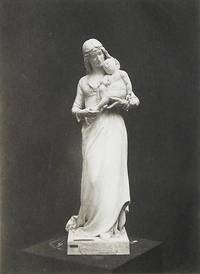
|
|
|
GAUTHIER Maximilien
E. Othon FRIESZ. Dix estampes originales présentées par Maximilien GAUTHIER
Paris Editions Rombaldi - Collection "Les Maîtres de l'estampe française contemporaine" 1949 en feuilles, couverture rempliée, emboitage éditeur
Bookseller reference : 012989
|
|
|
Gautier Theophile. Wood engravings by Howard Simon
Mademoiselle de Maupin
New York: Ives Washburn 1929. 373 pp. 8 plates. Covers rubbed and handled pages tanned throughout. Size: 8vo. Hardcover. Very Good/No Jacket. Ives Washburn Hardcover
Bookseller reference : 277110
|
|
|
Gautier Theophile. Simon Howard wood engravings by
Mademoiselle de Maupin
NY Ives Washburn 1929. Hardcover. Very Good. Limited edition 2000 copies. Black cloth-backed boards silver-pressed decoration and titles. Decorated dw. Decorated endpapers. Large 8vo. 374p. Frontispiece 7 other wood engraving reproductions. Dw spine toned else fine. A beautiful copy. Illsutrated. Wood engravings. Woodcuts. <br/><br/> NY Ives Washburn 1929 hardcover
Bookseller reference : utdeim404
|
|
|
Gautier Theophile. Simon Howard wood engravings by
Mademoiselle de Maupin
NY Ives Washburn 1929. Hardcover. Very Good. Limited edition 2000 copies. Black cloth-backed boards silver-pressed decoration and titles. Decorated dw. Decorated endpapers. Large 8vo. 374p. Frontispiece 7 other wood engraving reproductions. Dw spine toned else fine. A beautiful copy. Illsutrated. Wood engravings. Woodcuts. NY Ives Washburn 1929 hardcover books
Bookseller reference : utdeim404
|
|
|
GAUTIER (Gilbert).
La Chauve Souris.
50X33 cm.
Bookseller reference : 16338
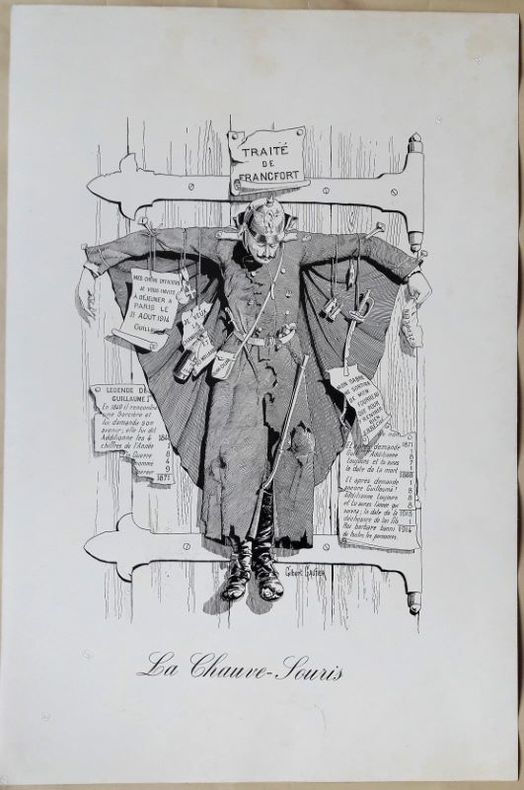
|
|
|
GAUTIER Lucien
Pont de l'Archevêché à Paris
[s. l.] [s. n.] [1882] Eau-forte dessinée et gravée par Lucien Gautier. 23,3 x 35,5 cm hors marges ; 34 x 41,5 cm toutes marges comprises.
Bookseller reference : 4904
|
|
|
GAUTIER-CONSTANT
Vous en ferez ce que vous voudrez
DU LYS. 1972. In-Folio. En feuillets. Très bon état, Couv. remarquable, Dos impeccable, Intérieur frais. Environ 50/75 pages. Nombreuses gravures, lettrines, vignettes et estampes en noir et blanc et monochromes, en hors-texte. Feuillets rangés dans une couverture souple. Emboîtage de l'éditeur sous forme de coffret avec une illustration dorée sur le 1er plat, et tissu rouge à l'intérieur.. . Sous Emboitage. . Classification Dewey : 769-Estampes
Bookseller reference : RO80042051

|
|
|
GAVARNI [Paul, Sulpice-Guillaume Chevalier dit
Lithographie originale de la série MASQUES ET VISAGES -18- Les parents terribles - lithographie
1852 [Paris], [Librairie Nouvelle, imprimerie Lemercier], sans date (vers 1852).grande feuille non rognée ,Dimensions de la feuille : 38,5 x 28 cm environ Dimensions de la lithographie : 19,5 x 16 environ Papier vélin fort. Tirage sur blanc (verso blanc). rare
Bookseller reference : 25946

|
|
|
GAVARNI Paul -
MASQUES ET VISAGES : PAR CI PAR LA et PHYSIONOMIES PARISIENNES , 2 suites - 100 splendides lithographies originales en noir de GAVARNI, tirées par LEMERCIER, en livraisons
PAULIN LE CHEVALLIER Editeurs de l'Illustration rue Richelieu 60. s.d. (1857). Grand in-folio (31x 43,5 cm).broché, en feuilles sous 10 chemises Collection de 100 splendides lithographies originales de GAVARNI, tirées par LEMERCIER, lithographies en noir numérotées de 1 à 50 dans les séries PAR CI PAR LA et PHYSIONOMIES PARISIENNES , 2 suites « Masques et visages ». Edition sur grand papier,bon etat
Bookseller reference : 15498
|
|
|